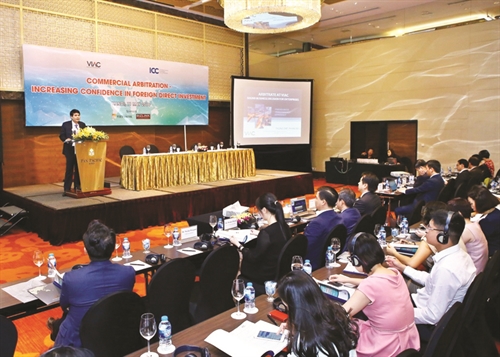Vietnam’s social security model has proved to be preeminent and suitable to the country’s socio-economic conditions as well as its development toward socialism. However, despite undeniable accomplishments, limitations and shortcomings still exist. This article reviews the situation and suggests orientations for development of social security in Vietnam.
Bui Van Huyen, Assoc. Prof.
Institute of Economics - Ho Chi Minh National Academy of Politics
Achievements in social security assurance
The preeminence of the social security model currently applied in Vietnam is manifested in several aspects.
Firstly, Vietnam has managed to set up a comparatively complete and comprehensive social security system with four major pillars: employment support and poverty reduction; social insurance; social assistance; and basic social services. These pillars have been operating in a relatively harmonious and synchronous manner, bringing about remarkable social security achievements highly appreciated by the people and international community. Regardless of whether the approach of life cycle, social protection floor or income risk response is applied, Vietnam’s social security model has sufficient mechanisms, programs and policies targeting different groups of beneficiaries, thus meeting social security demands in a fairly complete manner.
Secondly, the social security model of Vietnam is quite clear in its organizational structure, operational objectives and principles, as well as mechanisms for mobilizing and using resources and for making contributions to, and enjoying benefits from, social security schemes. Hence, Vietnam’s social security system can operate smoothly while adhering to the principles of universal access, sharing, equity and sustainability. In addition to the State’s resources which play an important role, social security programs also make use of social resources, contributions from employees and employers as well as voluntary contributions of individuals and organizations at home and abroad.
Thirdly, Vietnam has constantly renovated and improved its social security model in order to the extend social security coverage and increase social assistance levels, thus better meeting essential security needs of the people. Social security programs and policies have been renewed to be more effective, social security schemes extended, and the life of people, particularly those from disadvantaged groups, markedly improved.
Fourthly, the social security model has brought about the encouraging results which are acknowledged by the international community.
Particularly in the field of employment support and poverty reduction, the country has gained impressive achievements. At present, the unemployment rate is kept at just 2-3 percent with millions of new jobs created every year. Meanwhile, the poverty rate, measured by the multidimensional poverty standards, has quickly dropped to below 10 percent.
 |
| Representatives from ministries and sectors launch a specialized database serving the grant of health insurance cards to under-6 children__Photo: https://laodongxahoi.net |
Positive changes are also seen in the social insurance sector. Social insurance coverage has been broadened while insurance regimes have been improved, better meeting laborers’ security needs. The system of social insurance agencies has been set up from the central to local level. The legal system on labor and social insurance has been step by step improved. New social insurance schemes such as voluntary social insurance, family-based health insurance, and unemployment insurance are implemented while the scope of traditional ones, including compulsory social insurance and health insurance, is expanded. The procedures for the people to participate in social insurance and claim insurance benefits are getting simpler and more convenient.
Due attention has been paid to social assistance, contributing to guaranteeing the life of beneficiaries such as the elderly, people with disabilities, and persons affected by natural disasters. Social assistance services have also been gradually socialized, drawing the voluntary participation of social and business communities.
Improvement of basic social services, particularly education, healthcare, clean water, housing and communications, which serve as criteria for measuring poverty using the multidimensional approach, is another achievement of the social security sector in recent years. A raft of policies on development of social service infrastructure facilities in deep-lying and remote areas and areas inhabited by ethnic minority groups have been adopted in order to improve access to school, healthcare, clean water and information. Poor people and children have been given priorities and support in access to education and health services. Thanks to these efforts, Vietnam is now listed among countries with a high Human Development Index with impressive results in reduction of poverty in general and multidimensional poverty in particular and over 80 percent of the population covered by health insurance.
Limitations in social security regimes
Despite the gained achievements, limitations still exist in Vietnam’s social security model.
First of all, the country’s social security model covers a limited number of entities, including the poor, helpless people with disabilities, people incapable of caring for themselves, people aged over 80 years, and workers in the formal sector who participate in social insurance. As a result, less than one-third of the workforce is covered by social insurance; the rate of employees participating in unemployment insurance is low; and just a segment of persons in need have access to social assistance. Though the number of social insurance participants has incrementally increased over recent years from 10.2 million in 2011 to 13.8 million in 2017 and then 14.5 million in 2019, the coverage rate remains modest, just 20.3 percent in 2011 and 25.2 percent in 2017, equivalent to approximately one-fourth of the total workers aged 15 years or older. This means the majority of the workforce has not yet participated in social insurance and consequently has no social insurance benefits at present and in future when they reach the retirement age.
Meanwhile, the number of people who join social insurance on a voluntary basis accounts for a very small proportion of the total number of social insurance participants. After 10 years’ implementation, the voluntary social insurance scheme has had around 300,000 participants, a negligible figure, while the number of workers in the informal sector has mounted to 40 million. This shows that laborers are seemingly unaware of the benefits of voluntary social insurance or maybe voluntary social insurance is either unattractive or unaffordable.
Lack of sustainability is the second problem facing the social security system.
Against the backdrop of population aging, the social insurance fund is in danger of unsustainability and imbalance in the long run. In 2010, social insurance spendings equaled 73.9 percent of social insurance contributions. In 2015, the ratio reached 99.5 percent. If continuing to increase at such rate, social insurance spendings will soon surpass collections unless the social insurance scheme is reshaped. It is not to mention the fact that laborers, particularly business employees and industrial park workers, trend to claim for one-off payment of social insurance allowances, thus affecting the balance of the social insurance fund.
The rapid increase in social security spendings can also be cited as a reason behind the upsizing of the state budget’s current expenditures in recent years. Hence, there must be solutions for restructuring the state budget and further mobilizing social resources, otherwise, social security demands could not be satisfied or the state budget sustainability not ensured.
Unsustainability is also seen in poverty reduction. The poverty “relapse” rate is high while the poverty reduction rate among households in deep-lying, remote, and especially ethnic minority-inhabited areas, is low. Poor people’s livelihoods are restricted due to several causes, e.g., unavailability of financial and social resources, tough natural conditions and lack of infrastructure facilities, while their access to basic social services is limited. The rate of households having solid houses and clean water remains low. Given the fact that the current social allowance levels are modest, part of the population cannot reach the minimum living standards.
The overlap among social security pillars is the third issue. At present, there are different poverty reduction programs implemented in a locality. It is not to mention locally run programs, programs incorporated into other socio-economic development programs and projects, and programs and projects of domestic socio-political organizations, international organizations and local communities. As a result, available resources are thinned-out and become inefficient. In some cases, several localities receive excessive resources while others suffer shortage. Overlaps also exist between social security programs and state management functions by relevant sectors such as health, education, natural resources-environment, and information-communications.
Lastly, the state management of social security programs and projects is loose, giving rise to negative phenomena such as provision of support to ineligible subjects, profiteering of social insurance, health insurance and unemployment insurance funds, and inefficient use of social assistance funds, especially in emergency cases in response to natural disasters. Meanwhile, mechanisms for mobilizing and effectively using social resources for these activities are still lacking, leading to failure to promote the role of local communities in social security assurance.
Orientations for social security development
In order to provide people with better protection against income risks and easier access to basic social services, the social security system should be further renovated in the following directions:
Firstly, it is necessary to clarify the concept about and improve the model of a multi-tier social security model with special importance attached to the tier of basic social security. Social security is often thought of as a vertical system with major pillars being social insurance, social protection and poverty reduction. Now, it should be re-shaped into a three-tier system with the first tier being assurance of minimum healthcare and minimum income for poor people, unemployed people, elderly people, children, and other special subjects; the second tier- the basic social security tier, compulsory social insurance and other social security; and the third tier, voluntary social insurance. Though it is quite easy to imagine these three tiers of social security, especially the tier of basic social security, this approach must be further studied and improved so as to be implemented in a roadmap suitable to the country’s financial capacity.
Secondly, the growth model should be furthered renewed and the economy restructured toward quick, inclusive and sustainable development. In fact, economic growth is the foundation for social security assurance as it will help create jobs and income for the people, increase contributions to social security funds and state budget revenues, thus rendering support for the social security system. However, growth results in social security assurance only when the economy develops in an inclusive and sustainable manner in combination with social progress and environmental protection. Hence, the most crucial solution to social security issues is to develop a rapid, sustainable and inclusive economy that enables all the people to make contributions to and benefit from its growth.
Thirdly, employment creation and poverty alleviation programs should be accelerated and qualitatively improved. Shortage and loss of income in the working-age population is often associated with shortage and loss of jobs. Hence, it is necessary to further implement job creation programs in combination with socio-economic development and economic restructuring. In the coming years, poverty reduction will probably face many challenges since poor households mostly reside in mountainous, deep-lying and ethnic minority-inhabited areas with limited resources and access to livelihoods. The social security model should involve poor households in value chains so as to help them acquire stable and sustainable sources of income without having to rely on social allowances.
Fourthly, it is required to consolidate and develop social insurance schemes and expand the social insurance, health insurance and unemployment insurance coverage in the capacity as major pillars of the social security system. At present, except health insurance, social insurance and unemployment insurance coverage remains relatively limited and mainly exists in the formal economic sector. Meanwhile, a large number of laborers of the informal sector, who account for the majority of the workforce, have not yet participated in social insurance. This situation, on the one hand, lessens the role of social insurance in social security assurance while creating a great burden on the uninsured, especially when they reach the retirement age. On the other hand, it makes the social insurance fund become imbalanced. Therefore, social insurance coverage should be gradually increased toward the goal of universal social insurance.
Fifthly, preparatory steps should be taken in response to population aging, which has become a challenge all over the world and in Vietnam. The country’s population is aging at a high speed, creating great social security demands for the elderly on all major security pillars, including the pension system, healthcare and nursing homes for the elderly, and social protection for helpless elderly people. If not being well prepared, the social security system can hardly adapt to such changes.
Another important job to be done to cope with population aging is to adjust the mobilization of contributions to and use of the social insurance fund in a way that meets the demands of social insurance participants while still ensuring the fund balance in the coming time.
Sixthly, it is the time to increase socialization in the social security sector, especially employment and poverty reduction, social protection, and provision of basic social services. Social security requires great financial resources, therefore, in addition to contributions of social insurance participants, a large number of social security tasks, e.g., social protection, support for the poor and people with disabilities, still reply on the state budget. However, as the state budget is limited, funds should be raised from other sources for social security purposes. Socialization will help not only solve the financial question in social security but also improve the quality of social security services.
Seventhly, the legal system on social security should be improved. The current legal foundation for the social security system has been established in a relatively complete manner, comprising the Constitution, the Labor Code, and the Law on Social Insurance, among others. In the time to come, this legal foundation should be furthered completed, focusing on handling newly arising problems in a way that suits the reality, facilitates business operations and, at the same time, guarantees the interests of social insurance participants. Particularly, it is necessary to build the legal foundation for application of the multi-tier social security model, attaching importance on the regulations relating to the tier of basic social security such as basic pension regulations.
Lastly, social security policies and programs should be associated with one another so as to increase transparency and effectiveness while avoiding overlaps of contents and scattering of resources. These programs and projects, especially those on employment, poverty reduction, social protection, and provision of basic social services, should also be re-designed to be simple, transparent, and easy to implement and manage.-









